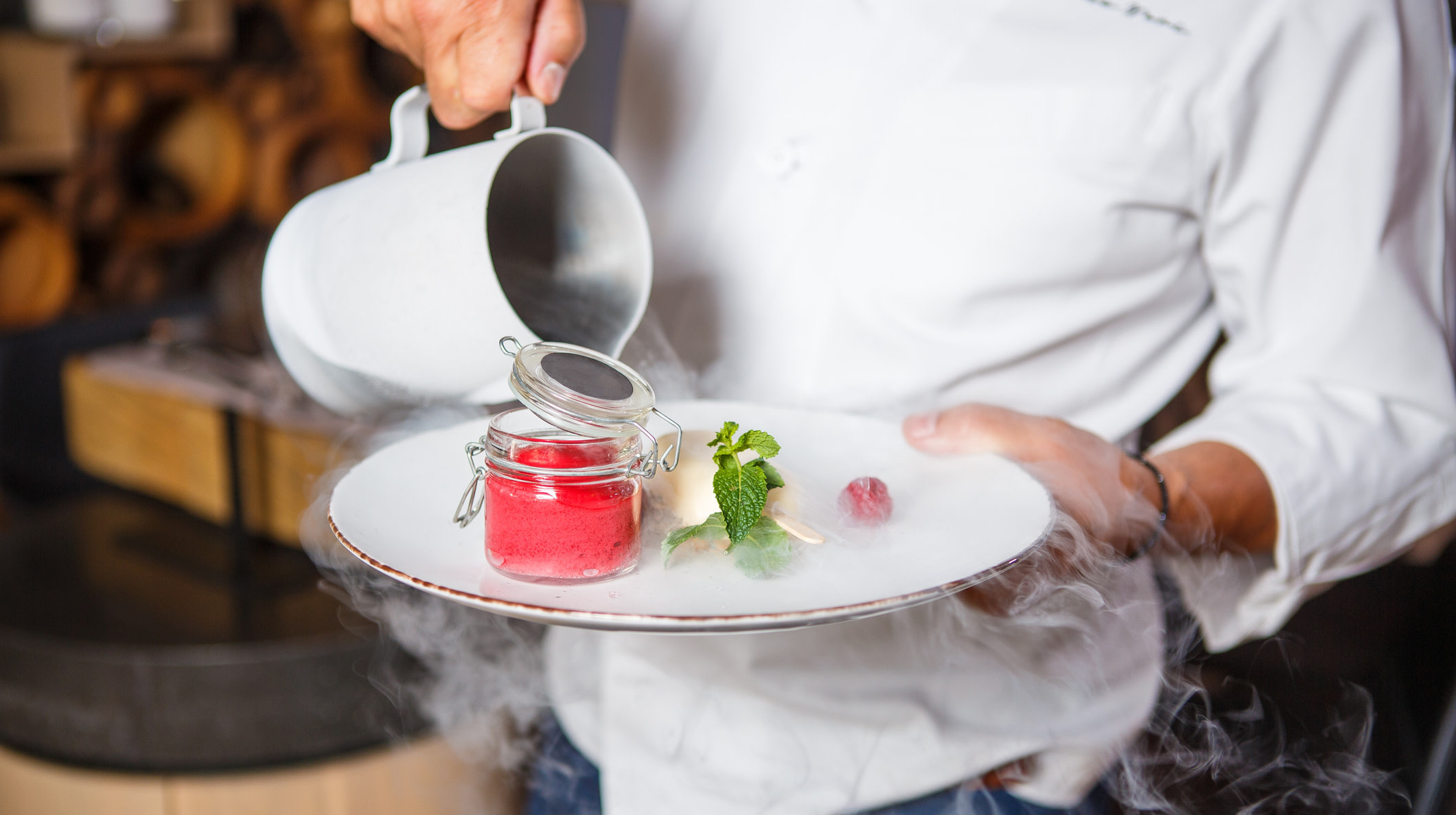Cooking With Dry Ice Is A Gas
To most of us, dry ice is just an odd hunk of smoking, frozen matter that we see at Halloween parties, used to make a cauldron or cocktail bubble. But dry ice is more than a spooky autumnal accent piece. It can actually be used as a tool in the kitchen, not just to help freeze foods, but to prepare unique and exquisitely textured dishes. And you needn't be a modernist chef to use it.
Dry ice, most basically, is the solid form of carbon dioxide (the stuff you breathe out, the infamous pollutant) created when its gas form is pressurized and cooled to at least -109.3 degrees Fahrenheit. Rather than melt when exposed to higher temperatures, it sublimates rapidly—five pounds of dry ice vaporizes in 24 hours—into a gas. Hence the fog.
First discovered in 1834, dry ice only came into commercial circulation around the 1920s, when it was used as a cooling agent in rail cars—just before the spread of modern refrigeration technology that was easier to work with. (It can be tricky to figure out how much dry ice you need in a given space, for a given item, to chill versus freeze it.) Despite being broadly displaced by the Frigidaires of the world, dry ice is still used by some people to chill foods faster than standard ice or a freezer, as dry ice is better maintaining its structural integrity. Crushed dry ice is also mixed into some fish and meat as it's processed to keep it at safe temperatures, without bogging it down with added moisture.
But first, a few notes of caution
No matter how you're working with dry ice, you'll want good ventilation. That also means you shouldn't store it in your freezer if it won't cool to -110 degree Fahrenheit. You also shouldn't dispose of dry ice in a closed trash can, as the release of gas can build pressure and cause a messy, noxious explosion. It's best stored in a cooler with the lid ajar, and disposed of by pouring warm water over it to speed its sublimation. (The pressure of unventilated dry ice does make it useful as bottle rocket fuel.)
And because dry ice has numerous non-culinary, industrial applications, check that you're purchasing food-safe dry ice, whether you intend to cook with it or just to throw it in a punch bowl. Hint: If you're buying your dry ice from a hardware store, industrial supplier, or wholesaler, it's likely not the food-grade stuff.
Get started cooking—or anti-cooking?—with dry ice
If the molecular gastronomy movement has taught us anything, it's that while we often focus on heat in the kitchen, cold has not just food-preserving but transforming potential. Food scientist Hervé This, a.k.a. the man who un-boiled an egg, argues we can't really call food preparation via cooling cooking. "This," he tells me, "could be called more properly cryocoction."
Granted, molecular gastronomist chefs and restaurants rarely work with dry ice, but this not for its lack of utility. It's because they have ready access to liquid nitrogen, which This notes is colder, at -321 degrees Fahrenheit or lower, and as a liquid is easier for professional chefs to work with than a clunky, chunky solid. At most, some pro chefs use its fog as a visible vehicle for scent infusions served alongside a meal. (You can replicate this at home by placing dry ice in an insulated teapot with an extract or crushed herb, placing the lid on, and letting aromatic fog flow out of the spout.)
For home cooks, however, dry ice is much easier to obtain and store than liquid nitrogen. Around Halloween especially, it's available at specialty ice or party stores, and some even sell it year-round for about $1 per pound, in 5-to 10-pound blocks or bags of pellets. You can even, in theory, make it at home; some DIY videos show how to do so using a fire extinguisher and pillowcase, but I wouldn't recommend it.
Dry ice is cold enough that touching it directly for more than a few seconds can cause serious frost burn, and swallowing it can cause potentially fatal internal organ damage. Dry ice stays at the bottom of most liquids, but can form enough water ice around itself to float upward, making it a somewhat risky choice to put it directly into a beverage. But you're perfectly safe handling it with simple tongs and leather work gloves. A towel or oven mitts, however, are not safe enough.
What can you actually make with dry ice?
The best-known, simplest application of dry ice might be its use as an at-home carbonation agent. Scooping shavings of it into a liquid can make beverages bubbly—although using too much turns liquids bitter. You'll get better effects by mixing water and a desired amount of sugar and some type of flavoring extract with dry ice in a large, covered jug, occasionally venting it. (See recipes for proportions.) You can even carbonate fruit with dry ice, a pressure cooker, and half an hour, if you're so inclined. When carbonating, though, it's important for personal safety to make sure all the dry ice you used has fully sublimated into a gas before drinking or eating whatever you're working with.
You can also use dry ice to make ice cream, without any special machine, in about 90 seconds. All you need are your desired ice cream ingredients (cream, sugar, flavoring, etc.), an insulated bowl, and a stand mixer with a paddle attachment. Slowly stir in dry ice shavings or chunks—not too fast or too many, or else you might carbonate the ingredients—to rapidly cool it into ice cream. This is one application where dry ice can actually have a leg up over liquid nitrogen: The latter agent cools ice cream ingredients so rapidly that they become super hard, while the former yields something more akin to the smoothest, fluffiest, most luxurious soft serve this side of McDonald's. It bears repeating: As with carbonated beverages, it's important to make sure all of your dry ice has sublimated out of the ice cream before eating it. A night in the freezer that isn't cold enough to chill foods to -110 Fahrenheit or lower is usually more than enough time, post-preparation, for small remnants of dry ice to sublimate.
Perhaps the most interesting uses of dry ice in the kitchen involve using it to create an at-home version of an Anti-Griddle, a $1,400 device developed by PolyScience and inspired by chef Grant Achatz that pumps a refrigerant under a steel surface to cool it to an even and consistent -30 degrees Fahrenheit, allowing easy flash-freezing of liquids, creams, and so on. (There are variants on this machine, like El Bulli's TeppanNitro, that consist of a metal bowl insulated on the outside and filled with liquid nitrogen, cooling a metal plate above it.) All you need to do to roughly recreate this is put a block of dry ice on a safe surface, like a wood block with a towel over it, and then place a greased cooking sheet on top of it—or take small chunks of dry ice and put them between two cooking sheets stacked on top of each other—and let it cool the metal surface for about 10 minutes. The result is colder than an Anti-Griddle, and far less evenly cooled, so you have to work faster and use it with more caution and consideration. Like the expensive versions, it can flash-freeze sauces, batters, and more to create foods with crisp and cold texture on the outside, gooey and warm texture on the inside.
You can also use dry ice to prepare some meats and seafood. The cold of a dry-ice-chilled cooking sheet is powerful enough to functionally cyrosear the skin or surface of fatty fish like salmon or tuna, and even red meat like duck breast, within a couple of minutes, creating a crisp exterior while maintaining the rich and soft texture of sushi or tartare just below it.
To be clear, cryocoction or cryosearing can kill some potential contaminants like parasites in meat or seafood, but won't zap all foodborne germs; after all, Hervé This notes, we use even colder materials like liquid nitrogen to cryogenically preserve still-living microbes. So when preparing meat or seafood using dry-ice-based tools or techniques, it is important to source sushi- or tartare-grade ingredients that you'd be comfortable eating raw. Or, one can use cryosearing as one step in a preparation that also involves heating the flesh to kill off nasty germs. The New York Times recently published a detailed and illustrated recipe for a particularly succulent duck breast, prepared by cryosearing the skin once before and once after cooking it on a plancha-style griddle.
Even with that limitation in mind, there is still so much to explore in the rapid freezing, texture-providing, and even carbonating potential of dry ice in one's own kitchen. Sure, dry ice is not a common cooking tool or ingredient, nor something you'd want to whip out on a daily basis. And the number of recipes that use it, while not exhaustively detailed in this article, are limited. But what it offers is still fun, unique, and useful—far more than a little decorative fog.

